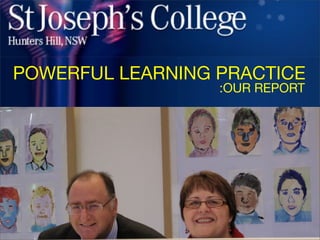SJC PLP: Our Report
- 1. POWERFUL LEARNING PRACTICE :OUR REPORT
- 2. Who we are, and why we were involved PLP allowed us to blend face-to-face and online curriculum to connect small teams from 20-forward thinking, independent and state/district schools from around the globe to establish a powerful, ongoing learning community. Explore issues around Digital Citizenship and develop an integrated program for Year 7. Better prepare our school to move forward in systemic ways after the one-year commitment ends by laying the groundwork for sustainable PLP project plans.
- 4. Left to Right Anthony Rooskie, Fergus Stewart, Lee MacMaster, Gary Molloy, Judy OˇŻConnell, Riccardo Bombardiere
- 5. What we launched Digital Citizenship ¨C Boys in Year 7 http://digital7.ning.com/ Digital Citizenship ¨C Learning Together http://digitalsjc.ning.com/ Working with the parents ¨C Ning, promotion, and parent presentations
- 9. AFTER ONE DAY! 180 members, 86 blog posts, 12 videos
- 10. USING NETS STANDARDS ...to develop a comprehensive curriculum with a program that addressed all key facets pertaining to digital citizenship
- 11. What we achieved Embedded into the curriculum ¨C not an add on! Our program is designed to work within a project-based, online learning environment in af?liation with the subject of English. http://www.scribd.com/doc/17733757/Digital-Citizenship-Year-7-Program-2009
- 12. Our Focus Areas
- 13. Focus 1 Introduction to Digital Citizenship. What does our future hold for us online? Focus 2 Digital Citizenship Rights and Responsibilities What are my rights and responsibilities as a digital citizen? What is our Digital Citizenship charter?
- 14. Focus 3 Our Digital Footprint Digital Footprints - the good, the bad and the ugly. Focus 4 What can I Do to stop Cyberbullying?
- 15. What we incorporated RSS feeds on digital issues Quizzes Writing and re?ecting in their own blogs Videos Images
- 16. What we learned individually, collectively and as a team. We learned how to engage our students with a Suite of Web 2.0 tools, using them for planning, communication and collaboration. This extended to Blogs, Wikis, şÝşÝߣshare, Flickr, UStream, Delicious, Twitter, Google Docs, and Elluminate. Now we can better inform?teachers about 21st century learning as an integrated approach to new pedagogies for mulitimodal learning and teaching, or work to develop intensively designed units of work that are driven by the transformative potential of the web.
- 17. Gary ¨C Team Leader ˇ°The PLP Project team have been empowered to drive change ensuring we adapt to the shifting learning literacies that the 21st century demands and how those literacies inform teacher practice.ˇ±
- 18. Lee ˇ°The bene?ciaries of our journey are our colleagues at St. Joseph's College and the boys we educate. ?We have had the opportunity to learn together as a team and make decisions about the appropriateness of new technologies and new ways of teaching and learning. To open the ?oodgate to all that is new would be disastrous - we must always select wisely and ensure St. Joseph's College is a "workplace of learners" ready and willing to meet the challenges of education in the 21st Century.ˇ±
- 19. Fergus ˇ°The use of a variety of student-centred Web 2.0 connective tools such as weblogs, wikispaces and other social networking multimedia, helps foster a more collaborative learning approach amongst staff and students.ˇ±
- 20. Anthony ˇ°The integration of technology will only happen if a teacher decides that they are 100% willing to give it a go. Nobody can prescribe a technology integration plan that will work for all. It is important for each teacher to personally experience and evaluate the bene?ts of all of the technologies, plan how they see it best ?ts and discover how it suits their own teaching styles.ˇ±
- 21. Ric ˇ°Two of the most salient challenges we face are in the areas of using emerging technologies more effectively in the classroom and preparing our students for the future by developing their digital literacy. We worked to energise staff with new ideas that will help all of us engage with technology and learning in a more meaningful way.ˇ±
- 22. Judy - 21st Century Fellow "ItˇŻs the team approach that is going to create a force for balanced change in ideas and innovation at our school, building capacity by strengthening knowledge and understanding of how to teach with technology in ways that are not 20th century.ˇ±
- 23. Lee Macmaster, Director of Teaching and Learning ? ˇ°This has been a journey without a ?xed destination for the PLP Team. We have been ?lucky to be part of a global project inspiring new insights, new ways of thinking, new ways of learning and educating our students. We have been?fortunate to have this opportunity to learn with each other, from each other and with our colleagues from around the world. This is indeed 21st Century learning at its best.ˇ±
























